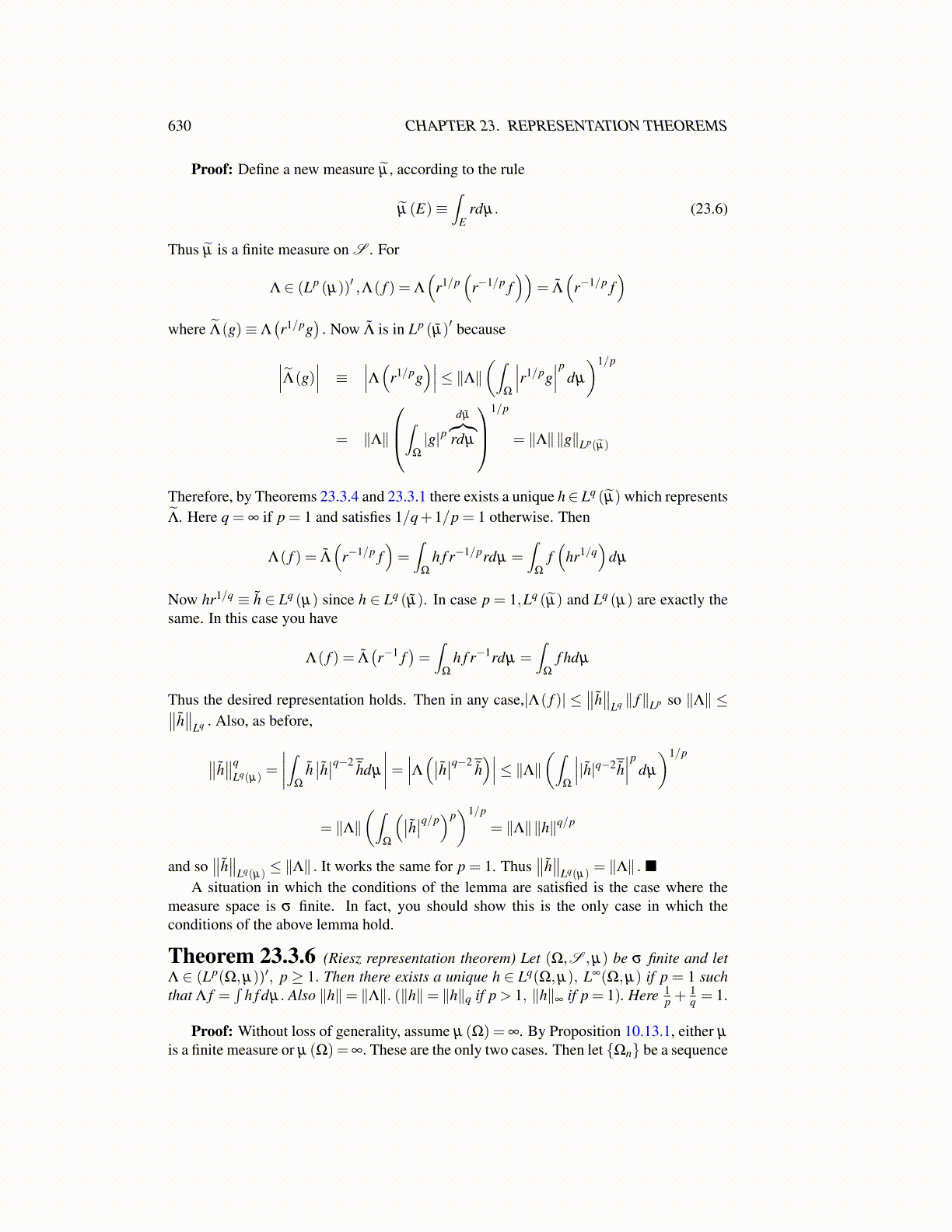
630 CHAPTER 23. REPRESENTATION THEOREMS
Proof: Define a new measure µ̃ , according to the rule
µ̃ (E)≡∫
Erdµ. (23.6)
Thus µ̃ is a finite measure on S . For
Λ ∈ (Lp (µ))′ ,Λ( f ) = Λ
(r1/p
(r−1/p f
))= Λ̃
(r−1/p f
)where Λ̃(g)≡ Λ
(r1/pg
). Now Λ̃ is in Lp (µ̃)′ because
∣∣∣Λ̃(g)∣∣∣ ≡ ∣∣∣Λ(r1/pg
)∣∣∣≤ ∥Λ∥(∫Ω
∣∣∣r1/pg∣∣∣p dµ
)1/p
= ∥Λ∥
∫Ω
|g|pdµ̃︷︸︸︷
rdµ
1/p
= ∥Λ∥∥g∥Lp(µ̃)
Therefore, by Theorems 23.3.4 and 23.3.1 there exists a unique h∈ Lq (µ̃) which representsΛ̃. Here q = ∞ if p = 1 and satisfies 1/q+1/p = 1 otherwise. Then
Λ( f ) = Λ̃
(r−1/p f
)=∫
Ω
h f r−1/prdµ =∫
Ω
f(
hr1/q)
dµ
Now hr1/q ≡ h̃ ∈ Lq (µ) since h ∈ Lq (µ̃). In case p = 1,Lq (µ̃) and Lq (µ) are exactly thesame. In this case you have
Λ( f ) = Λ̃(r−1 f
)=∫
Ω
h f r−1rdµ =∫
Ω
f hdµ
Thus the desired representation holds. Then in any case,|Λ( f )| ≤∥∥h̃∥∥
Lq ∥ f∥Lp so ∥Λ∥ ≤∥∥h̃∥∥
Lq . Also, as before,
∥∥h̃∥∥q
Lq(µ)=
∣∣∣∣∫Ω
h̃∣∣h̃∣∣q−2 h̃dµ
∣∣∣∣= ∣∣∣Λ(∣∣h̃∣∣q−2 h̃)∣∣∣≤ ∥Λ∥(∫
Ω
∣∣∣|h̃|q−2h̃∣∣∣p dµ
)1/p
= ∥Λ∥(∫
Ω
(∣∣h̃∣∣q/p)p)1/p
= ∥Λ∥∥h∥q/p
and so∥∥h̃∥∥
Lq(µ)≤ ∥Λ∥ . It works the same for p = 1. Thus
∥∥h̃∥∥
Lq(µ)= ∥Λ∥ . ■
A situation in which the conditions of the lemma are satisfied is the case where themeasure space is σ finite. In fact, you should show this is the only case in which theconditions of the above lemma hold.
Theorem 23.3.6 (Riesz representation theorem) Let (Ω,S ,µ) be σ finite and letΛ ∈ (Lp(Ω,µ))′, p ≥ 1. Then there exists a unique h ∈ Lq(Ω,µ), L∞(Ω,µ) if p = 1 suchthat Λ f =
∫h f dµ. Also ∥h∥= ∥Λ∥. (∥h∥= ∥h∥q if p > 1, ∥h∥∞ if p = 1). Here 1
p +1q = 1.
Proof: Without loss of generality, assume µ (Ω) = ∞. By Proposition 10.13.1, either µ
is a finite measure or µ (Ω) =∞. These are the only two cases. Then let {Ωn} be a sequence